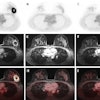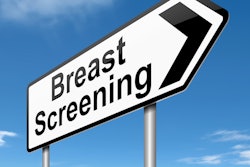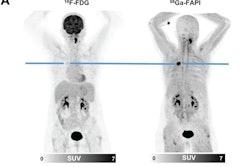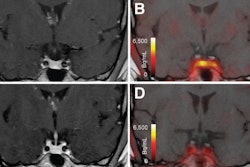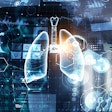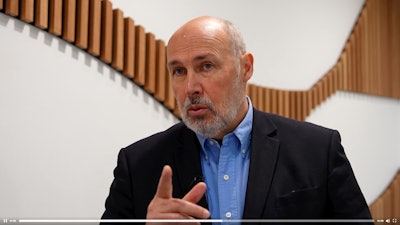 Parizel is the David Hartley chair of radiology at the University of Western Australia (UWA) in Perth.
Parizel is the David Hartley chair of radiology at the University of Western Australia (UWA) in Perth.
It's time for radiology and nuclear medicine to bury their historical differences and work more closely together, says former European Society of Radiology president Prof. Paul Parizel, PhD. Cooperation offers benefits such as improved patient care, better dissemination of medical knowledge, and increased efficiency in healthcare delivery, he insists.
In this wide-ranging Q&A interview, Parizel also speaks about contrast media shortages in CT and what he misses about Europe.
Q: Why do you feel so strongly that radiology should work more closely with nuclear medicine?
A: I think there are five main reasons why the two disciplines should cooperate closely:
- All-inclusive diagnostic capabilities. Collaboration expands the diagnostic toolkit available to clinicians. Integrating the technology offers clinicians access to a more comprehensive assessment of anatomical structures and physiological processes within the body, leading to more accurate diagnoses and treatment planning. Now is the time for our communities to see the skill sets of radiologists and nuclear medicine physicians as complementary, rather than being in competition with each other.
- Enhanced therapeutic opportunities. Theranostics has opened new horizons for nuclear medicine, such as targeted radionuclide therapy, which can be used to treat e.g., prostate cancer and thyroid disorders. Close cooperation allows for seamless integration of high-resolution diagnostic imaging data (anatomical targets) with functional data (treatment response assessment and optimized therapy delivery).
- Improved patient management. Collaboration will streamline patient management workflows, e.g., optimized scheduling, reduced wait times, and enhanced overall efficiency. It will allow for integrated diagnostic reports with findings from both disciplines and facilitate informed decision-making and personalized treatment strategies. Also, it will ensure new and exciting developments such as theranostics aren't hijacked by clinicians and organ specialists, who may lack the profound understanding of anatomy and pathophysiology needed to treat patients adequately.
- Advancement of research and innovation. Collaboration stimulates interdisciplinary research initiatives and promotes innovation in imaging technology and techniques. It can accelerate scientific discovery, improving disease detection, treatment monitoring, and drug development.
- Holistic approach to education and training. By exposing trainees to diverse imaging modalities, educational institutions can produce practitioners with a deeper understanding of both anatomical and functional aspects of disease.
Q: Why has the relationship between radiology and nuclear medicine in Europe been so turbulent?
A: Almost two decades ago, the European Society of Radiology (ESR) and the European Association of Nuclear Medicine (EANM) started a dialogue. A first milestone occurred in 2007, when both societies published a white paper on multimodality imaging. They committed to working together on an equal and constructive basis to develop common procedural guidelines and research opportunities. In 2010, the societies published a joint survey on multimodality imaging and stated they were in favor of an interdisciplinary training scheme. While this was successfully implemented in the Netherlands, the proposal never gained wide acceptance across Europe, to the best of my knowledge.
In the mid-2010s, during my years as ESR president and chair of the ESR Board of Directors, I attended (and chaired) several meetings between the ESR and the EANM. These were difficult discussions. There is a lot of mistrust on both sides. The disparity in numbers may have been a contributory factor. The ESR now has over 137,000 members, whereas the EANM claims 2,900 individual members, meaning there is a ratio of 1:45. The fear has always been that nuclear medicine would be swallowed up by radiology in a hostile takeover.
Given that negotiations stalled, and appeared to be going nowhere, in 2016, the ESR announced the foundation of a new subspecialty society: the European Society for Hybrid, Molecular and Translational Imaging (ESHIMT). This did not help to improve relations with the EANM leadership, who claimed that their specialty reaches far beyond hybrid imaging and is fully deserving of its own independent curriculum and recognition as a medical specialty.
The bone of contention has everything to do with the growing role of theranostics, i.e., radioligand therapy which uses the same target for both imaging and treatment. Theranostics has the potential to become a game changer in cancer care. However, there is a very real concern that theranostics may be taken over by specialists in radiation oncology, urology, oncology, neurology, and endocrinology. Close collaboration between diagnostic imaging and nuclear medicine specialists provides the best opportunities for patient-centered workflows and integrated care. This view is often not shared by medicine physicians, most of whom would prefer to collaborate with clinicians and ‘embed’ theranostics within an oncologic practice.
When two dogs fight for a bone, a third may run away with it, and I am very much afraid this could happen with theranostics. While radioligand therapy offers great opportunities for patients, setting up the infrastructure does pose a challenge to healthcare authorities and payers. A strong alliance between diagnostic imaging and nuclear medicine can assist in careful patient selection, streamlined workflows and optimized patient care, with the ability to assess treatment results through quantifiable imaging biomarkers. These opportunities could be lost in a ‘vertically integrated’ model, with oncologists or organ specialists controlling and managing the treatment.
In politics, the doctrine of the separation of powers (legislative, judicial, executive) developed by Montesquieu in 1748, holds that the concentration of power in any single person or group of people is a threat to liberty. Similarly, in medicine, it makes sense to separate the diagnostic process from the treatment path, and to create checks and balances. This model will help to prevent patients and doctors from making bad decisions and it will offer the best opportunity to reduce the economic burden on the healthcare system.
Q: At the Western Australia National Imaging Facility (WA NIF) Node, you work closely with nuclear medicine physician and associate professor Roslyn Francis, PhD. How did this come about?
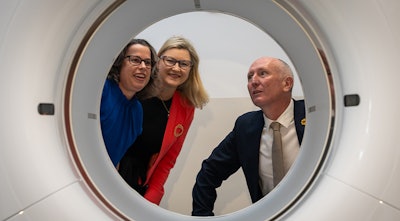 Associate Professor Roslyn Francis (left), Prof. Anna Nowak, and Science and Medical Research Minister Stephen Dawson at the launch of the WA NIF Node in October 2023.
Associate Professor Roslyn Francis (left), Prof. Anna Nowak, and Science and Medical Research Minister Stephen Dawson at the launch of the WA NIF Node in October 2023.
A: I met Ros shortly after my arrival in Perth. She impressed me with her scientific acumen, as well as her involvement in many advanced trials in diagnostic nuclear medicine and in theranostics. We had regular meetings and we bemoaned that medical students get very little exposure to imaging in the medical school curriculum, and discussed how we could change that. We developed a core imaging course, introducing different aspects of imaging. We've offered these lectures now for three years, and the UWA Medical School gave me an "excellence in teaching" award.
When, in June 2020, the deputy vice chancellor for research invited me to serve as director of the WA NIF Node, I accepted on condition that I could share the responsibility with Ros Francis, so we are co-directors, thereby establishing an academic partnership between diagnostic imaging and nuclear medicine.
Q: Do you think such collaboration would have been possible in Europe?
A: Difficult to say. It depends on the relationship between diagnostic imaging and nuclear medicine, which is different in every country. For example, in the Netherlands, the societies of radiology and nuclear medicine implemented an integrated residency training program in 2015, with the aim of ensuring quality and efficiency of reporting and streamlining communication. In a 2022 paper, the perceived strengths of the integrated training program included broadening of expertise, better preparation of future imaging specialists for hybrid imaging, and increased efficiency in training residents and in multidisciplinary meetings. Perceived weaknesses of the integrated training program included reduced exposure to nuclear medicine, less time for research and innovation, and concerns about its international recognition.
However, such a combined program was not universally welcomed, and in the nuclear medicine literature, there has been a strong reaction against this initiative by U.S. and German authors, who have called it "an ill-fated Dutch experiment." In Belgium, the gulf between radiologists and nuclear medicine physicians is quite wide, and no such integrated program is available (even though some hospitals, e.g., Vitaz Hospital in Sint-Niklaas, have fully integrated medical and molecular imaging).
Q: When it comes to training in PET/CT and PET/MRI, which institution's approach has impressed you most? Do you think training in hybrid imaging works best when it's radiology-led?
A: I have been very much impressed by the pioneering work of Erasmus Medical Centre, Rotterdam, which co-created the transformative field of theranostics.
The second question is difficult to answer. It really depends on the people and on the local circumstances.
Q: In May 2023, you spoke out on the CT contrast media shortage. Do you think the lessons have been learned?
A: No, unfortunately not. In 2024, the great contrast media shortage is over. Most hospitals have forgotten all about it and reverted to their old ways of procuring contrast, focusing purchasing decisions mainly on price and obtaining 80% or more from the cheapest vendor.
Procurement and supply decisions must be patient-centric. When price is the predominant factor in rating tender responses, it exposes healthcare systems and patients to significant risks, as demonstrated during the COVID-19 pandemic. Pricing matters, but it should never be the main determinant. Much more important are the qualitative criteria (non-price), which include quality, safety, relevant experience, stability of supply, patient- and healthcare-related benefits, and opportunities for scientific collaboration.
In this area, cheaper does not mean better, and the products are not all the same. Newer generation contrast media may be more expensive -- not 'just because they are,' but because research time and energy have been invested to design products with improved safety profile, better patient tolerance, less adverse side effects, and higher diagnostic accuracy. Radiologists must get involved in these decisions since they hold the ultimate responsibility when something goes wrong.
Q: What's your main priority for the rest of 2024?
A: My main goal is to expand the activities of the WA NIF Node and to provide high-quality, standardized, reproducible, and quantitative imaging for clinical trials that use imaging data as surrogate endpoints. Given the human experts (NIF Fellows) and the high-end research equipment for preclinical and human imaging, we have the potential to become a world-leading research facility.
Q: On a personal level, are you still enjoying life in Perth? What do you miss most/least about Europe?
A: Perth is a wonderful place to live. With a population of 2 million people, it's a mini metropolis on the Indian Ocean shores, with stunning beaches, exquisite natural scenery, ample parklands, and award-winning wineries. Perth has all the amenities of a modern city, with few of the disadvantages. There's a thriving culture of the performing arts, including theaters, symphony ensembles, ballet, cabaret, and live music. We have excellent healthcare services and educational opportunities. Perth offers a high-quality lifestyle, with perfect weather and a mild Mediterranean climate. There is a great food culture mixing European and Asian cuisines and everything in between. Public transport is good; I ride the Metro Train to work every day, and it's very convenient.
Do I miss Europe? I obviously miss seeing my family and especially my granddaughter. I also miss seeing friends, colleagues, and former trainees. And I miss being able to get in a car, hop on a train or jump in a plane for a weekend trip to somewhere. Perth has been called the world's most isolated big city, and indeed it is. Closest to Perth is Adelaide, the capital of South Australia, which is 2,100 km away (a 3-hour flight). Australian East Coast cities, such as Sydney, Brisbane, or even Melbourne are a four- to five-hour flight away, as is Singapore.
Perth is very far away from everything else, which has both disadvantages and advantages. But the people are warm and welcoming, and it has been a privilege to work at Royal Perth Hospital and the UWA.




